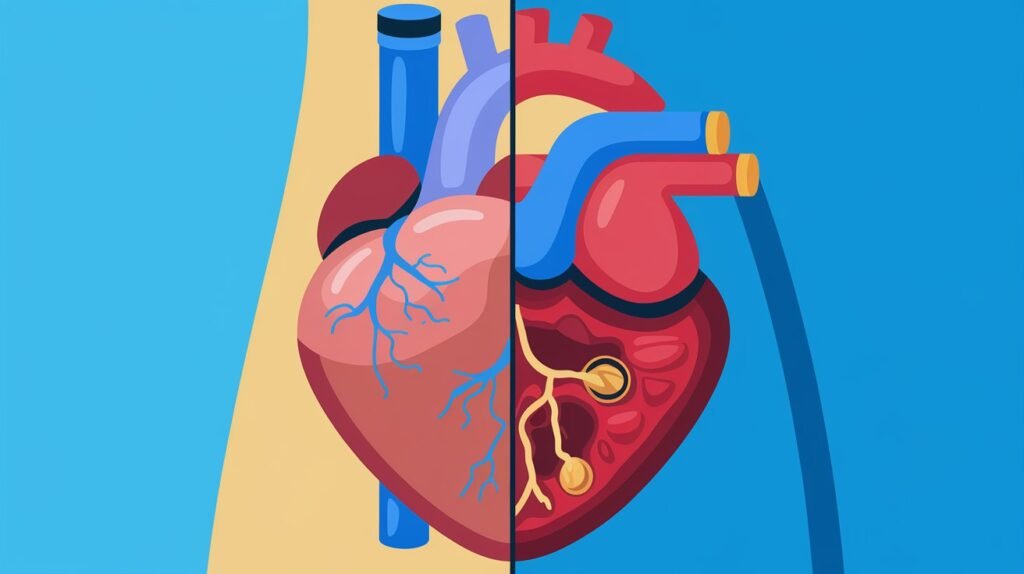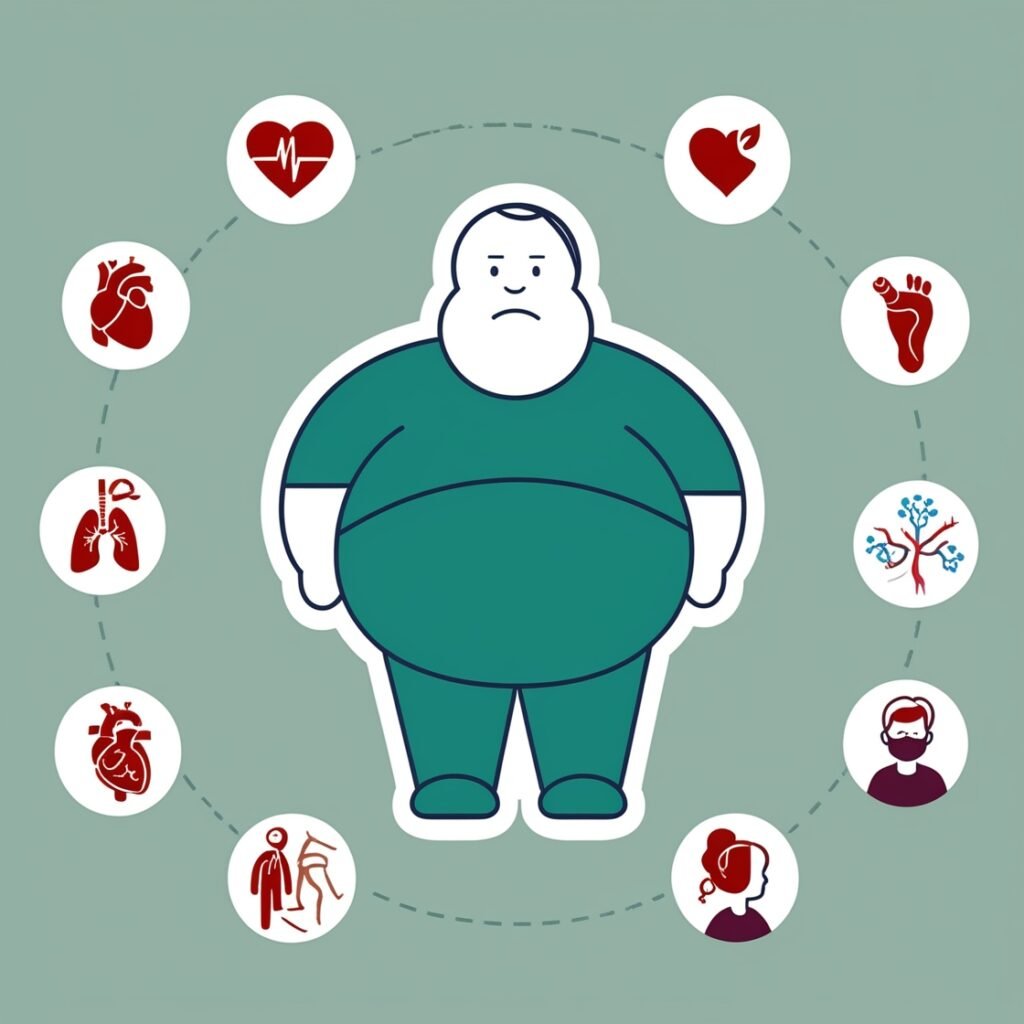Obesity is one of the most significant public health issues worldwide, and its prevalence continues to rise. It not only impacts quality of life but also increases the risk of numerous chronic conditions, including heart disease. Heart diseases remain a leading cause of death globally, and their link to obesity is well-established. This article will explore the intricate relationship between obesity and heart diseases, why being overweight contributes to cardiovascular problems, and how individuals can protect their heart health.
Table of Contents
Introduction to Obesity and Heart Disease
Obesity is defined by an excessive amount of body fat. Clinically, it is measured using the Body Mass Index (BMI), where a BMI of 30 or more indicates obesity. Heart diseases, or cardiovascular diseases (CVDs), encompass a wide range of conditions affecting the heart and blood vessels, including coronary artery disease (CAD), heart attack, stroke, and heart failure. Obesity plays a significant role in the development of these conditions due to its influence on several cardiovascular risk factors.
Obesity and Heart Disease
The Global Impact of Obesity and Heart Disease
The connection between obesity and heart disease is alarming. According to the World Health Organization (WHO), over 1.9 billion adults were overweight in 2016, with over 650 million classified as obese. Simultaneously, heart diseases continue to claim the most lives worldwide, contributing to an estimated 17.9 million deaths annually. As obesity rates climb, so does the burden of cardiovascular diseases, creating a dangerous public health crisis.
How Obesity Affects Heart Health

Obesity contributes to heart disease through multiple mechanisms, which include:
1. Hypertension (High Blood Pressure)
One of the most common consequences of obesity is hypertension. Excess fat tissue requires more oxygen and nutrients, increasing the workload on the heart. As the heart works harder, the force against artery walls increases, leading to high blood pressure. Hypertension is a major risk factor for heart disease and stroke.
2. Dyslipidemia (Abnormal Cholesterol Levels)
Obesity is often associated with dyslipidemia, characterized by high levels of low-density lipoprotein (LDL) cholesterol (often called “bad” cholesterol) and triglycerides, and low levels of high-density lipoprotein (HDL) cholesterol (“good” cholesterol). High LDL and triglycerides contribute to the build-up of plaque in the arteries, narrowing them and increasing the risk of coronary artery disease and heart attack.
3. Insulin Resistance and Type 2 Diabetes
Obesity is closely linked to insulin resistance, a condition where the body’s cells do not respond effectively to insulin. This often leads to type 2 diabetes, another major risk factor for heart disease. Diabetes damages blood vessels and contributes to atherosclerosis (narrowing of the arteries), increasing the risk of heart attacks and strokes.
4. Chronic Inflammation
Excess body fat, particularly around the abdomen, leads to chronic low-grade inflammation throughout the body. Inflammation is a significant contributor to the development of atherosclerosis, where fatty deposits build up in the arteries, increasing the risk of heart disease.
5. Sleep Apnea
Obesity also increases the likelihood of obstructive sleep apnea, a condition where breathing stops and starts during sleep. Sleep apnea can contribute to hypertension and puts a significant strain on the cardiovascular system, raising the risk of heart disease.
Statistics on Obesity and Heart Disease
The following statistics highlight the strong link between obesity and cardiovascular diseases:
- According to the Centers for Disease Control and Prevention (CDC), 40% of Americans are obese, and nearly 50% of U.S. adults have some form of cardiovascular disease.
- Studies have shown that individuals with a BMI of 30 or higher have a 49% increased risk of coronary artery disease compared to those with a normal BMI.
- A report by the American Heart Association (AHA) found that 70% of obese adults have at least one additional cardiovascular risk factor, such as high cholesterol or high blood pressure.
Table: Obesity and Cardiovascular Risk Factors
| Risk Factor | Obese Population (%) | Non-Obese Population (%) |
|---|---|---|
| Hypertension | 60% | 30% |
| High LDL Cholesterol | 45% | 25% |
| Type 2 Diabetes | 35% | 10% |
The Mechanisms Behind Obesity-Induced Heart Diseases

1. Atherosclerosis
Atherosclerosis is the buildup of fatty deposits, or plaques, inside the arteries. These plaques narrow the arteries, reducing blood flow to the heart. Obesity accelerates this process through inflammation, high LDL cholesterol, and elevated blood pressure.
When arteries supplying blood to the heart are blocked, it can lead to angina (chest pain) or a heart attack. If a blockage occurs in the arteries leading to the brain, it can result in a stroke.
2. Heart Failure
Heart failure occurs when the heart can no longer pump blood efficiently to meet the body’s needs. In obesity, the heart is forced to work harder to circulate blood throughout the increased body mass, leading to left ventricular hypertrophy (thickening of the heart muscle) and eventually heart failure.
3. Coronary Artery Disease (CAD)
Coronary artery disease is one of the most common heart conditions linked to obesity. It occurs when the arteries supplying blood to the heart become narrowed due to plaque buildup. This condition can result in myocardial infarction (heart attack), arrhythmias (irregular heartbeats), and sudden cardiac arrest.
4. Stroke
As obesity increases the risk of atherosclerosis and hypertension, it also raises the likelihood of ischemic stroke, where a blood clot blocks the flow of blood to the brain, and hemorrhagic stroke, where a blood vessel in the brain bursts.
Preventing Heart Disease Through Weight Management
1. Diet and Nutrition
A healthy diet is one of the most effective ways to reduce the risk of both obesity and heart disease. Diets rich in fruits, vegetables, whole grains, lean proteins, and healthy fats (such as the Mediterranean diet) can help manage weight and reduce cardiovascular risk factors like high cholesterol and hypertension.
Key Dietary Tips:
- Reduce intake of saturated and trans fats, which raise LDL cholesterol levels.
- Increase consumption of fiber, as it helps lower cholesterol and promotes satiety.
- Limit sugar and refined carbohydrates, which contribute to insulin resistance and obesity.
- Monitor portion sizes and caloric intake to achieve a healthy weight.
2. Regular Physical Activity

Physical activity is crucial in preventing both obesity and heart disease. Aerobic exercises like walking, running, swimming, or cycling improve heart health by strengthening the cardiovascular system and aiding in weight loss. The American Heart Association recommends at least 150 minutes of moderate aerobic activity or 75 minutes of vigorous aerobic activity per week.
3. Behavioral Changes
Implementing long-term behavioral changes is critical in preventing obesity and heart disease. This includes stress management, getting adequate sleep, and addressing emotional eating. Behavioral therapy can help individuals identify unhealthy eating patterns and adopt healthier habits.
4. Medical and Surgical Interventions
For individuals with severe obesity (BMI ≥ 40), lifestyle changes may not be sufficient to achieve significant weight loss. In such cases, medical interventions like pharmacotherapy (weight loss medications) or bariatric surgery may be considered. These treatments not only result in weight loss but also improve cardiovascular health by reducing blood pressure, cholesterol levels, and the risk of heart failure.
Success Stories: The Impact of Weight Loss on Heart Health
Numerous studies have shown that even modest weight loss can significantly reduce the risk of heart diseases. A 2015 study published in The New England Journal of Medicine found that losing just 5-10% of body weight can lower blood pressure, improve cholesterol levels, and reduce the risk of developing heart disease.
Case Study:
Jane, a 45-year-old woman with a BMI of 35, participated in a weight management program that combined diet, exercise, and behavioral therapy. After losing 12% of her body weight, she saw a 15-point reduction in systolic blood pressure and a 20% drop in LDL cholesterol levels. Her risk of heart disease decreased by 30%.
Table: Benefits of Modest Weight Loss on Cardiovascular Health
| Weight Loss (%) | Blood Pressure Reduction (mmHg) | LDL Cholesterol Reduction (%) | Risk of Heart Disease Reduction (%) |
|---|---|---|---|
| 5% | 5 mmHg | 10% | 15% |
| 10% | 10 mmHg | 20% | 30% |
Obesity and Heart Disease: The Conclusion
Obesity and heart disease are intrinsically linked, with obesity contributing to various cardiovascular risk factors, including hypertension, dyslipidemia, and diabetes. The good news is that by addressing obesity through lifestyle changes—such as improved diet, increased physical activity, and behavioral interventions—individuals can significantly reduce their risk of heart disease.
By understanding the connection between obesity and heart diseases, individuals can take proactive steps to manage their weight and protect their heart health. If you’re struggling with obesity, consulting a healthcare professional about weight management options could be the key to preventing life-threatening heart conditions.
References
- World Health Organization. (2021). Obesity and Overweight.
- American Heart Association. (2020). Heart Disease and Obesity.
- Centers for Disease Control and Prevention. (2021). Obesity and Cardiovascular Risk.




